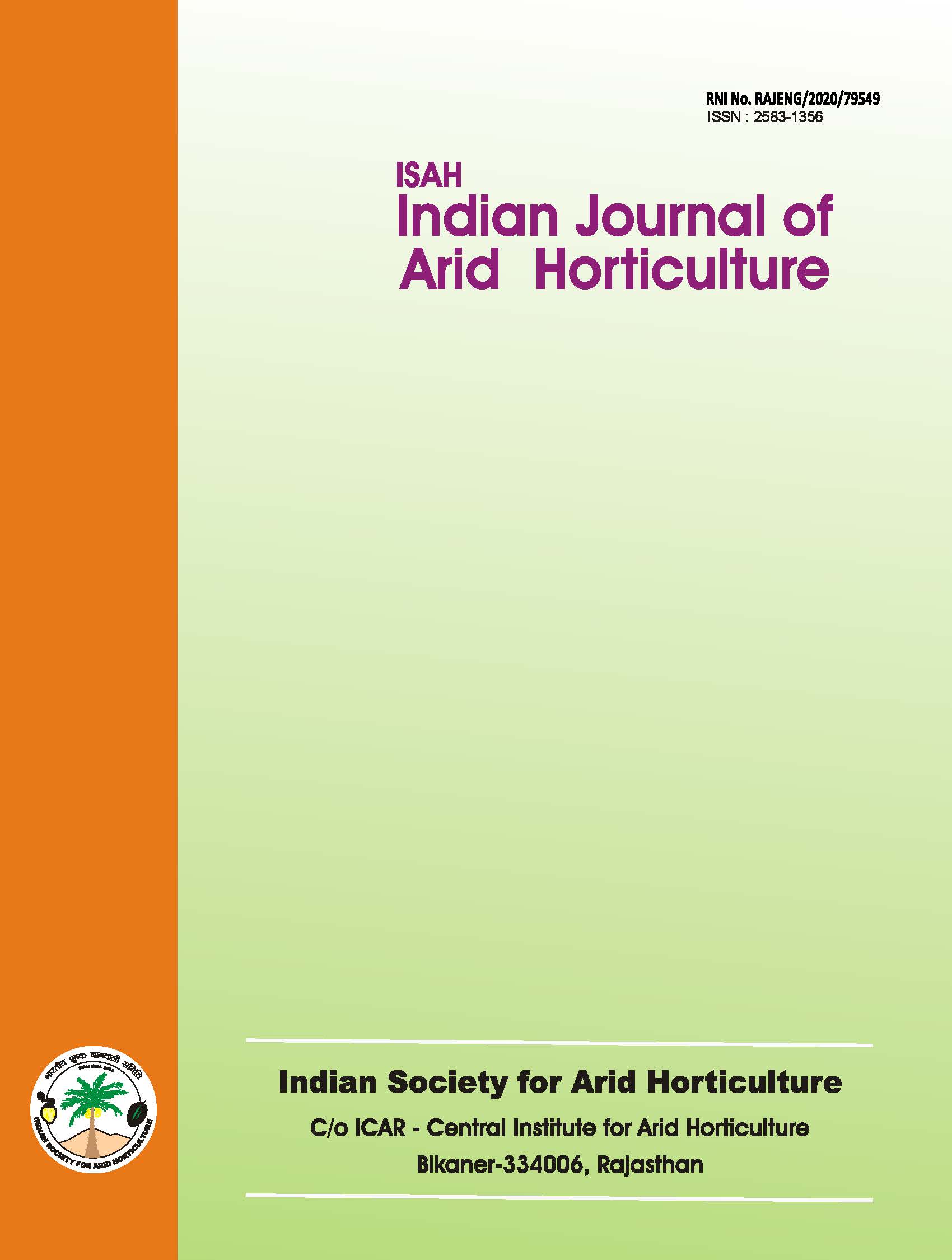Influence of weed control treatments on available soil nutrient and plant growth parameters of guava (Psidium guajava L.)
DOI:
https://doi.org/10.48165/ijah.2022.4.1.04Keywords:
Herbicides, guava, weed free, soil nutrients, leaf areaAbstract
This study aimed to evaluate the effects of different weed control methods on soil health and growth parameters in guava cultivation. In this study, 9 years old guava plants of cultivar L-49 at CCSHAU, Hisar were selected during the years 2019-20 and 2020-21. A total of twenty-one treatments were applied on guava trees. Soil and leaf nutrient levels were assessed along with growth parameters including plant height, canopy spread, chlorophyll content anwwd leaf area. Among herbicides, glyphosate (1.26 kg/ha) + carfentrazone (20 g/ha) resulted in the highest levels of N (261.77 and 263.86 kg/ha), Zn (6.79 and 6.80 mg/kg), and Fe (2.26 and 2.28 mg/kg) and glyphosate (1.26 kg/ha) + oxyfluorfen (100 g/ha) led to the maximum levels of P (30.20 and 31.27 kg/ha) and K (298.67 and 299.66 kg/ha) respectively. The maximum leaf area (52.21 cm2 and 54.56 cm2) and the greatest increase in plant spread (ranging from 6.12% to 7.15%) were recorded in the treatment with glyphosate (1.26 kg/ ha) combined with carfentrazone (20 g/ha). The highest increases in plant height were observed with the application of glyphosate (1.26 kg/ha) combined with carfentrazone (20 g/ha) and glyphosate (1.26 kg/ha) combined with oxyfluorfen (100 g/ha), with percentage increases ranging from 6.91% to 7.05% and 6.90% to 7.07%, respectively. Additionally, manual weeding and mulching also resulted in better growth parameters, including increased plant height and canopy spread.
Downloads
References
Abouziena, H.F. and Haggag, W.M. 2016. Weed control in clean agriculture: A review. Planta Daninha, 34(2): 377-392. Anonymous 2020. Second advance estimate. National Horticulture Board, Government of India, Gurgaon, Haryana, India. Ashiq, M., Sattar, A., Ahmed, N. and Muhammad, N. 2007. Role of herbicides in crop production. Unique enterprises 17-A, Gulberg colony, Faisalabad, Pakistan.
Banaszkiewicz, T. and Kopytowski, J. 2003. Some aspects of glyphosate use in apple orchards. Sodininkyste ir Darzininkyste, 22: 41-46.
Bond, W. and Grundy, A. C. 2001. Non-chemical weed management in organic farming systems. Weed Research, 41: 383-405. Cerda, J.J., Mendoza, M., Santiago, J., Nieto, F. and Cortez, S. 1999.
Weed chemical control in apple (Pyrus malus L.) coadjuvants. Agronomia Mesoamericana, 10(1): 7-15.
Chatha, R.P.S. and Chanana, Y.R. 2007. Studies on weed management in young peach orchards. Indian Journal of Horticulture, 64: 300-303.
Hanway, J.J. and Heidel, H.H. 1952. Soil analysis methods as used in Iowa State College, Soil Testing Laboratory. Iowa State College Bull., 57: 1-131.
Lindsay, W.L. and Norvell, W.A. 1978. Development of a DTPA soil test for zinc, iron, manganese and copper. Soil Science Society of America Journal, 42: 421-28.
Merfield, C. N. 2013. False and stale seedbeds: The most effective non-chemical weed management tools for cropping and pasture establishment. Lincoln: The BHU Future Farming Centre, 23.
Olsen, S.R., Cole, C.V., Watanabe, F.S. and Dean, L.A. 1954. Estimation of available phosphorus in soils by extraction with sodium bicarbonate. United States Department of Agriculture, Washington, 939.
Palma, L., Novello, V., Montemurro, P. and Gisell, A. 2002. Ecological and agronomic response of Vitis vinifera L. cv. Italia to different techniques of soil management. Italus Hortus, 9(4): 15-22.
Pathak, S.M., Singh, D.K. and Singh, V.K. 2007. Effect of herbicides on growth, weed infestation and physio-biochemical changes in guava (Psidium guajava L.) seedling. Acta Horticulturae, 735: 315-320.
Sawhney, V. and Singh, D.P. 2002. Effect of chemical desiccation at the post-anthesis stage on some physiological and biochemical changes in the flag leaf of contrasting wheat genotypes. Field Crops Research, 77(1): 1-6.
Soni, J.K., Amarjeet, Punia, S.S. and Choudhary, V.K. 2021. Herbicide combinations for management of resistance in Phalaris minor. Indian Journal of Weed Science, 53(1): 41-48.

